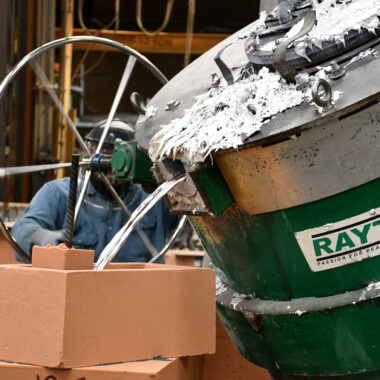Unlocking Excellence: Aluminum Casting Techniques & Tips for Superior Results
Unlocking Excellence: Aluminum Casting Techniques & Tips for Superior Results
Blog Article
Study the Globe of Light Weight Aluminum Spreading: Understanding the Various Methods
Aluminum spreading is a fundamental process in the production industry, with numerous approaches used to create exact and intricate parts. From the traditional sand spreading approach to the sophisticated die casting process, each method provides distinct benefits depending on the demands of the job.
Sand Casting Technique
Sand spreading, a widely-used approach in aluminum casting processes, includes creating molds made of compressed sand for putting liquified metal. When the mold is all set, it is safely put in a flask and molten aluminum is poured right into the tooth cavity.
After the metal has cooled down and solidified, the sand mold is escaped to expose the aluminum casting. Sand spreading permits the production of complex forms and large components that may be expensive or hard to produce using various other techniques. It is additionally a sustainable strategy as the sand can be recycled and utilized several times, reducing waste in the spreading procedure.
Irreversible Mold Technique

One substantial benefit of the Permanent Mold Method is the boosted dimensional accuracy it provides. The metal mold and mildew enables for tighter tolerances and better information in the final light weight aluminum castings contrasted to sand casting methods. This accuracy makes it a recommended option for applications where tight dimensional control is essential, such as in the vehicle and aerospace industries.

Die Casting Process

Financial Investment Casting Strategy
Using a precision casting technique, Financial investment Casting Method entails developing elaborate aluminum components by putting molten steel into a ceramic mold. This process, also recognized as lost-wax spreading, begins with the development of a wax pattern of the wanted component. This wax pattern is after that covered with a ceramic product to form a covering. When the ceramic covering is solidified, it is heated up to remove the wax, leaving behind a hollow ceramic mold and mildew.
The next action involves pouring the molten light weight aluminum right into the ceramic mold and mildew. The aluminum fills the tooth cavity left by the wax pattern, taking its form exactly. This approach is favored for its capacity to generate complicated forms with high accuracy and a smooth surface area finish. Financial investment casting is frequently made use of for making elements in sectors where complex layouts and limited resistances are called for, such as aerospace, vehicle, and clinical equipment. The flexibility and accuracy of the Financial investment Casting Technique make it a beneficial method worldwide of light weight aluminum casting.
Lost Foam Spreading Approach
Having actually checked out the detailed precision of Investment Casting Technique, the focus currently moves to the innovative technique of Lost Foam Spreading in light weight aluminum component production. Lost Foam Casting, also known as evaporative pattern casting, is a contemporary technique where a foam pattern of the preferred part is created and then covered with a refractory material.
Among the primary benefits of Lost Foam Spreading is its capacity to produce complicated forms with intricate information, typically in a solitary piece without the need for additional machining. This technique is likewise weblink understood for its high dimensional accuracy and smooth surface area finish. Furthermore, Lost Foam Spreading is a cost-efficient process as it decreases the need for cores and permits the production of lightweight parts. Regardless of its benefits, Lost Foam Casting calls for mindful control of the casting procedure to prevent problems and guarantee high quality parts.
Final Thought
Finally, aluminum casting supplies a variety of methods such as sand spreading, permanent mold technique, pass away casting, investment spreading, and lost foam spreading. Each technique has its very own advantages and applications, webpage making light weight aluminum casting a functional and widely utilized process in various sectors. Recognizing the differences in between these techniques is important in picking one of the most appropriate casting method for particular production demands.
Sand spreading, a widely-used approach in aluminum casting processes, includes developing molds made of compressed sand for putting molten steel. aluminum casting.The Irreversible Mold And Mildew Technique, like sand casting, is another prevalent technique employed in light weight aluminum spreading processes, supplying unique benefits in terms of mold and mildew reusability and dimensional accuracy. The metal mold enables for tighter resistances and better details in the final aluminum castings contrasted to sand spreading approaches. The two major kinds of die spreading are chilly chamber die casting and hot chamber die casting, each suitable for different kinds of light weight aluminum alloys.In final thought, aluminum spreading supplies a range of methods such More hints as sand spreading, irreversible mold method, die casting, financial investment spreading, and shed foam casting
Report this page